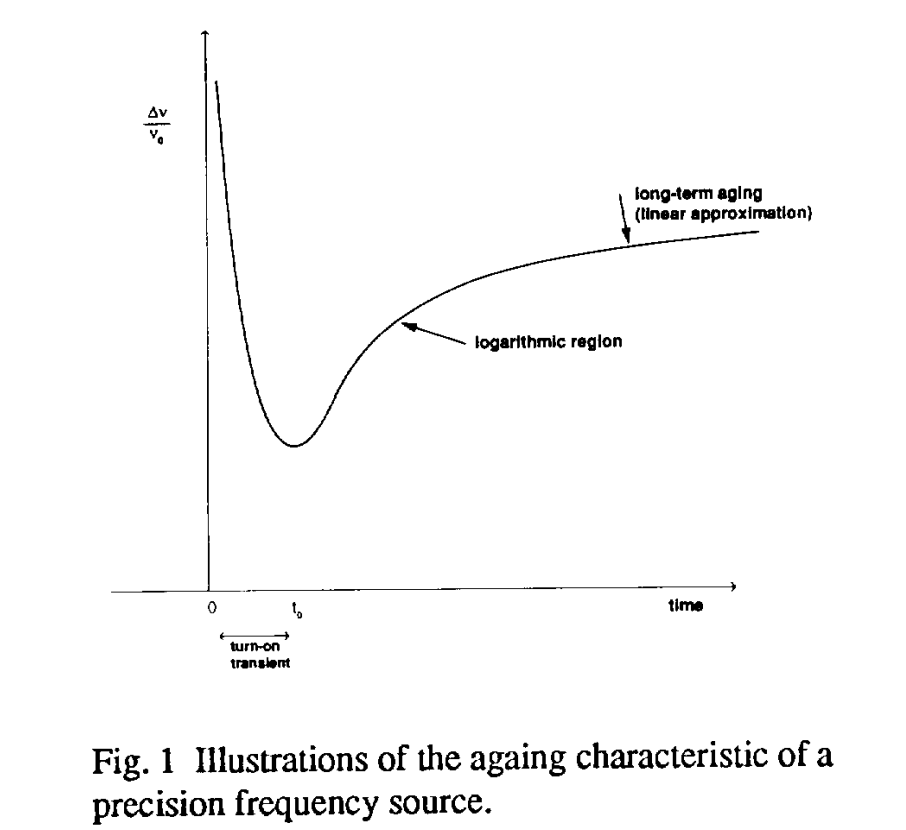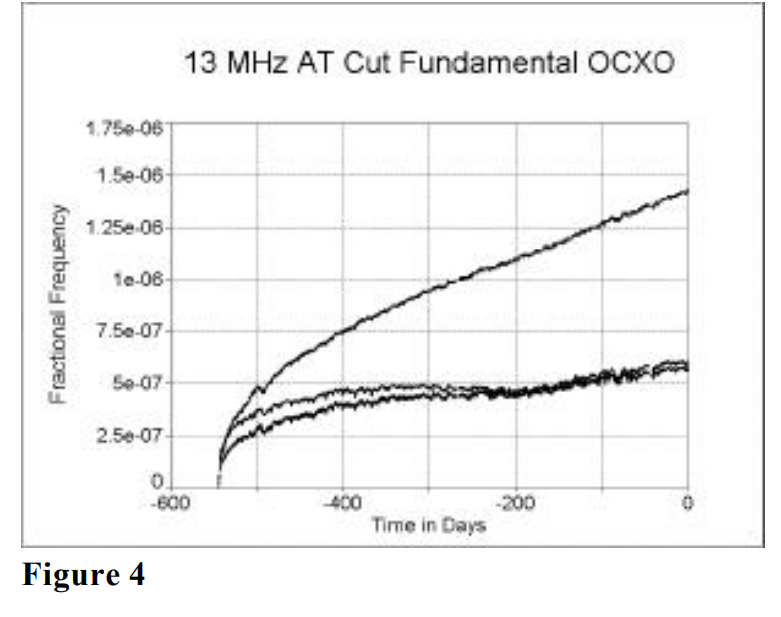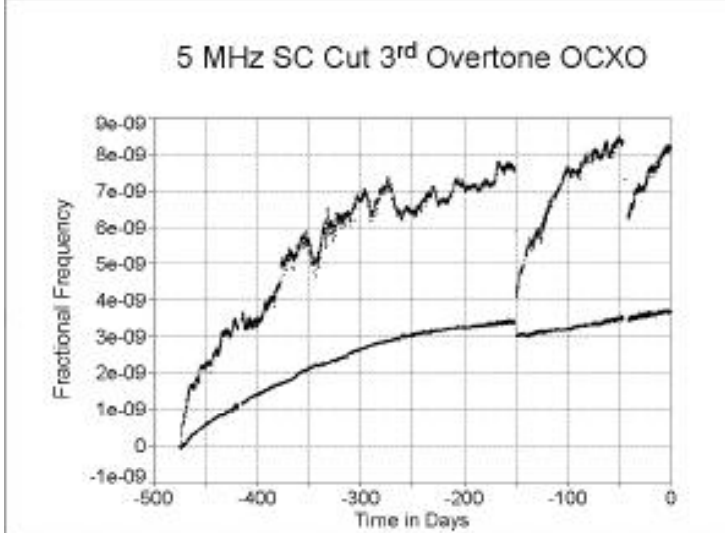Quartz crystals have frequency drift with time. Such drift is usually stated over small time frames like one month. Does the drift settle down? How would things be when restoring comms gear from the 1970s? Does this mean that a quartz crystal has a shelf life when accurate frequency is important?
-
1\$\begingroup\$ Autistic, your question is excellent. I strongly suspect that watch-makers have brought this art to a serious level of science, long ago. And if they wanted to share their secrets, I'm sure they could tell you a great deal. (I had a similar question about 30 years back, spoke with someone who worked in the watch-making industry, and was told pretty much what I just wrote here.) You could find out yourself by setting up a testing room that accelerates aging through higher temperature operation or by over-driving the power applied to the crystals. \$\endgroup\$periblepsis– periblepsis2025-10-12 04:33:08 +00:00Commented 2 days ago
-
1\$\begingroup\$ Shelf life will be a more difficult problem to ascertain. The crystals can't be subjected to unusual stresses so the only way to get good data here simply takes time. \$\endgroup\$periblepsis– periblepsis2025-10-12 05:10:25 +00:00Commented 2 days ago
4 Answers
There are multiple potential causes of aging, some tend to settle down, some are more linear.
Here is an overview from a NIST publication ca. 1970:
Crystal Oscillators (XO): The relatively low noise and high aging of a typical crystal oscillator generally results in a well-defined fit to an aging model. The aging is usually determined by such processes as stress relaxation and redistribution of contamination that decrease with time and are often described by a logarithmic model. Some units exhibit a change in sign of aging. This is because there is more than one source of aging of opposite signs.
Actual "very long term" (more than a year) measurements show samples having either characteristic as dominant:
Note that these are OCXO (ovenized) oscillators so the crystal is running at elevated temperature, which tends to greatly accelerate aging while it largely eliminates short-term environmental effects such as room temperature changes. However, it also eliminates aging effects that may be related to temperature cycling, though. So caution is called for in applying conclusions to non-ovenized oscillators.
As to the root causes, the 2nd paper has a laundry list of such causes:
Aging in quartz crystals is the result of a combination of several factors. Some of these factors may include the diffusion of impurities and the outgassing of the quartz crystal, its holder, the glass or ceramic base and the adhesive used to mount the quartz. It may also include metal migration from the electrodes into the quartz surface. These events involve an exchange in the mass of the quartz crystal which causes a change in its frequency. Other factors that also contribute to the aging of quartz crystals include stress relief of the crystal mounts and microscopic holder leaks. While gross leaks in holders are known to cause a downward shift in the frequency, the effects of microscopic leaks on long term aging performance is not well understood.
SiTime has some measurements of their products (makers of oscillators which may also function as sensitive helium sensors) vs. quartz crystals however this is not included because their idea of "long term" is a few weeks.
-
\$\begingroup\$ Is
makers of oscillators which may also function as sensitive helium sensorsconsidered a bug or a feature? \$\endgroup\$Chester Gillon– Chester Gillon2025-10-12 10:03:29 +00:00Commented yesterday -
3\$\begingroup\$ @ChesterGillon Very much a costly undocumented bug. My iPhone quit (apparently) permanently twice when a cryostat in the shop was being warmed up from 4.2K. Lost all the non-backed up photos when Apple wiped and swapped out phones. In reality they recovered in less than a week, but a really unexpected effect from a few % of He in the office air. Apple didn't figure it out and distribute the information widely until much later, despite multiple occurrences (mostly in hospitals). I read about it on the internet. \$\endgroup\$Spehro 'speff' Pefhany– Spehro 'speff' Pefhany2025-10-12 10:30:10 +00:00Commented yesterday
-
1\$\begingroup\$ @Spehro'speff'Pefhany I assume you're aware, but for the audience: I think that was He migrating into MEMS oscillators, not into quartzes, but the remark is very valid: small molecules, long timescales: things migrate and change material properties! \$\endgroup\$Marcus Müller– Marcus Müller2025-10-12 12:56:31 +00:00Commented yesterday
-
2\$\begingroup\$ @MarcusMüller Yes, that's right. It's relevant to this question because as a supplier of an alternate technology SiTime might be expected to enthusiastically point out flaws of their competitors. And they did so, and it's interesting. Unfortunately the aging time scale of their comparison was shorter than I believe OP was thinking of - since they mentioned shelf life. BTW, they say they've fixed the issue. \$\endgroup\$Spehro 'speff' Pefhany– Spehro 'speff' Pefhany2025-10-12 13:20:08 +00:00Commented yesterday
-
1\$\begingroup\$ @Spehro'speff'Pefhany: I had reports from people claiming that cycling in a vacuum chamber speeds up the recovery time \$\endgroup\$PlasmaHH– PlasmaHH2025-10-13 10:25:07 +00:00Commented 19 hours ago
Usually the de facto way of mentioning quartz crystal aging is in PPM per year. A very typical value being in the order of +/- 5 PPM per year maximum.
The most aging will happen during first year, and it generally won't be that close to the 5 PPM rating. Each year it ages less. So it won't be 50 PPM after 10 years.
I have encountered one manufacturer which mentions in their appnotes that for a crystal with 5 PPM per year aging, they target that total aging should be within 10 PPM. While not an official specification, it sounds like a reasonable value.
Which is why in sensitive equipment the aging must be accounted for in the error budget, for example things like Ethernet requires 50 PPM tolerance, so if 10PPM is left for aging, you might have 20PPM for tolerance and 20PPM for temperature stability.
Does this mean that a quartz crystal has a shelf life when accurate frequency is important?
Yes, kind of! However, As the others have said, aging is fastest at the beginning, but it will be much slowed if the quartz is not used, and you can get almost all the aging that happens in the first year of use, even after 20 years of having an unused device sitting on a shelf.
Plus, while of minor importance during construction, the load capacitance of a quartz oscillator circuit does influence the frequency. And capacitors age (CERN study on that topic; we're talking more than 25% of deviation of capacitance over age, and that's for modern film capacitors, which probably are among the most stable kinds), as well! I'm not sure what contribution is going to be worse after 50 years: the capacitors losing a solid amount of their capacity, or the quartz losing a dozen ppm (or so).
Needs actual measurement!
But, calibrating expectations:
when accurate frequency is important
means that you'll probably want a modern quartz to replace the ones on the shelf, either way, unless that quartz is of verifiably excellent heritage. Quartz production did get a lot better in the last 50 years – simply because of automation that makes it easier to very reproducibly create devices, and test, and categorize them – as a manufacturer today, you can decide how intensely you test your quartzes, and then, what your tolerances are; when you sell them as 10 ppm quartz, you can sell them at a higher price than when you produce 25 ppm quartzes, but you will get to throw out a higher amount of quartzes, namely those that fall in between 10 and 25 ppm. In the 1970s, costs were generally higher, so "precision rated" quartzes were doubly expensive. Problem is that not all quartz cuts that any given radio device in the 1970s used will be commercially available at low quantities, so that inverts that pricing (because you don't benefit from economies of scale).
Note that I think a lot of the old-school "canned" quartz resonators were at best shipped with a 50 ppm frequency accuracy – that is the very low end of quality for modern quartz resonators. So, even if there was no aging at all, if you have the chance, you'd rather buy a new 10 ppm quartz than to use the original one!
So, interestingly, the answer here might be: yes, they have shelf aging. Whether or not you throw them away might, however, more depend on the condition of the rest of the circuitry, the availability of replacement quartzes, and the ability to retrofit the device with an external oscillator (instead of fitting them with a replacement resonator, which is used by the oscillator circuit in the device). For typical 1970's radios frequencies, programmable oscillators do exist – again, not replacement for quartz crystals, but for the whole oscillator circuit that's more than just the crystal – that are accurate enough, and whose spurs might be so high in frequency, they might not matter to the radio (and these will exist, due to the functional principle of these programmable oscillators actually being a reference oscillator and typically an analog/digital hybrid fractional-N frequency synthesizer).
Aging is usually ±1-5 ppm per year. This means that in 10 years the frequency may change by ±10-50 ppm.
Ppm is 0.00001%, so that is small enough plus quartz resonator aging factor is at its peak in first month, so the resonator is at least more accurate than a ceramic resonator.
So, it is a minor factor even in accurate frequency settling (Arduinos that use quartz resonator doesn't faint at first year and clocks can be synchronized with atomic clock every few months).
The question is very, very good and difficult so I'll upvote it once I'll get 5 reputation.
-
\$\begingroup\$ Oh, heck. If all you need is 5 reputation -- here it is. I'll upvote your answer just for that, alone. Now you have what you need! ;) My pleasure. \$\endgroup\$periblepsis– periblepsis2025-10-12 06:42:22 +00:00Commented yesterday
-
2\$\begingroup\$ This is wrong. The PPM isn't 50 PPM after 10 years for a 5 PPM per year crystal aging. And no the question is not difficult. \$\endgroup\$Justme– Justme2025-10-12 06:56:37 +00:00Commented yesterday


